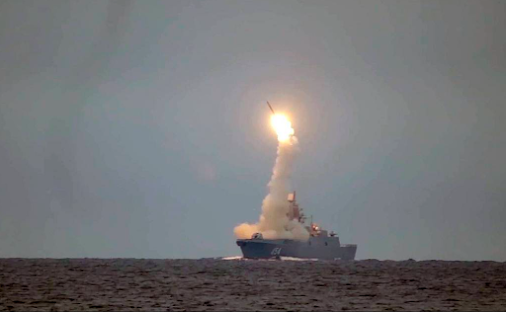Another missile in the sm family the SM-3 was even used to shoot down a
satellite in 2008. In November, the US Army announced it was adapting the
SM-6 into a ground-launched version to cover mid-range strike needs.
Later this year, the pentagon says that unspecified versions of the SM-6
have already demonstrated some degree of capability against these types of
weapons. examples of which russia and china have already begun putting to
service.
A new variant of the sm-6, the block 1B is already under development and
will itself be able to reach hypersonic speeds.
This is not the first time the pentagon has publicly discussed using a
variant of the SM-6 for hypersonic defense. In march 2020 Michael Griffin
then the under secretary of defense for research and engineering, first
revealed that this missile was among those being considered for this role
and that there were plans to test one of them against an actual hypersonic
boost glide vehicle sometime in the 2023 fiscal year.
The present versions of the SM-6 in use have a top speed of roughly 3500
miles per hour but according to the Pentagon, the block 1B missiles are
getting a substantial engine upgrade that could push them into hypersonic
speed.
The current model of sm-6 is nearly 5 million dollars and the hypersonic
extended range sm-61b will no doubt cost more.
Of the 10 major missiles that armed the navy's 285 and growing surface ships
and submarines, only the sm-6 is capable of striking targets at sea in the
air and at the edge of the atmosphere.
The navy plans to buy 1800 SM-6 through 2026 at a total cost of 6.4 billion
dollars. The missile armed Certain destroyers and cruisers equipped with the
aegis radar system. As of late 2018 the US fleet included 38 Aegis warships
that are compatible with the missile defense interceptors such as the SM-6,
the navy growing that number to 41 in 2019.
The SM-6 missile has a length of 6.6 meters and a diameter of 0.5 meters. It
weighs 3,306 pounds and carries a 160 pounds blast fragmentation warhead.
The interceptor uses semi-active homing and active homing guidance to
achieve accurate engagement of the assigned targets.
The SM-6 is a frankenstein's monster that features components raytheon
borrowed from other missile types. It combines the seeker and blast warhead
of an advanced medium-range air-to-air missile and the airframe of the
navy's older SM-2 surface-to-air missile.
The tomahawk and its controversies might make headlines, but as the us navy
re-arms for high-tech warfare the sm-6 is the missile to watch.
SM-6 is capable of sweating down air-breathing threats, such as fixed-wing
planes, helicopters and cruise missiles. while also being able to intercept
ballistic missiles during their terminal phase of flight.
In addition SM-6 also has a secondary strike capability and is able to hit
fixed targets on land and moving targets, such as ships, at sea with great
precision over long ranges, its high speed and quasi ballistic missile
motive attack makes it hard to defend against.
The type is also being developed as potentially a key component of future
hypersonic weapons defense architecture.
Hypersonic weapons like ballistic missiles fly at speeds of at least mach 5
or roughly one mile per second. Unlike ballistic missiles hypersonic weapons
do not follow a ballistic trajectory and can maneuver on route to their
target. russia reportedly fielded its first hypersonic weapons in december
2019.
While china field its first in 2020, the united states is not expected to
field hypersonic weapons before 2023. Hypersonic systems take advantage of
speed, maneuverability and sustained flight in the altitude gap between air
defenses and ballistic missile defenses to provide the transformational
capability for survivable long-range, lethal time-critical strike of heavily
defended and high-value targets.
The standard missile 6, SM-6 also known as rim 174 is a ship launched
anti-air an anti-surface interceptor missile developed by raytheon company.
The SM-6 is part of raytheon standard missile family, which also includes
standard missile 1, standard missile 2 and standard missile 3.
The technology of the standard missile family has expanded from defending
ships to defending continents. Thanks to the innovation and foresight of
industry and government team,s the standard missile will continue to evolve
and advance.



